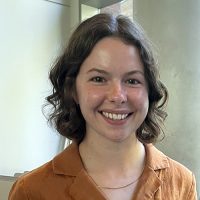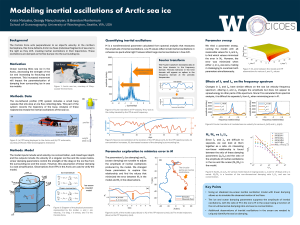
Krista Matuska
University of Washington
Research Mentor: Georgy Manucharyan
Project: Modeling inertial oscillations of Arctic sea ice
I’m Krista Matuska and I am studying Applied Math and Atmospheric Science at the University of Washington. This summer I worked with Georgy Manucharyan and Brandon Montemuro at the School of Oceanography on modeling the inertial oscillations of Arctic sea ice. When a floe (an individual sheet of sea ice) is pushed by a force, like the wind, its velocity is deflected to the right by the coriolis force. This deflection results in inertial oscillations in the floe’s trajectory, which are damped by the surrounding ice as well as the ocean. Ocean warming is reducing sea ice extent, thickness, and strength, causing it to fracture and move more. These changes affect the damping experienced by floes from the surrounding ice, which further impacts how this damping is parameterized in sea ice models. My project focused on using a simplified ice-ocean coupled model to simulate observed inertial oscillations and better understand how to parameterize the damping on floes from surrounding ice.
The model took input of wind velocity, sea ice concentration, and mixed-layer depth and output the floe velocity and the ocean velocity below. Damping from surrounding ice and the ocean were represented by linear damping parameters. Throughout the summer, I spent most of my time analyzing model output in MATLAB. I adjusted the linear damping parameters and compared the model output to observed floe trajectories, recorded by ice-tethered profilers deployed in the Arctic. More specifically, I compared the modeled and observed amplitude of inertial oscillations, which can be measured by the nondimensional parameter M, calculated from spectral analysis of either the floe or ocean velocity. One complication I ran into was that the ice and ocean damping parameters affected M very similarly. This made it difficult to know how the ice and ocean damping should be tuned separately to replicate the M values in observations. As a result, I looked at these damping parameters together as a ratio and found that the modeled ratio of M in the ice to M in the ocean was a function of the ratio of ice damping to ocean damping as well as sea ice concentration. This relationship can help resolve the right ratio of damping parameters to fit the observed ratio of M in the ice to M in the ocean and sea ice concentration.
Another important part of my summer was attending group meetings where I got to share my progress and hear about the other research being conducted by interns, graduate students, and postdocs in physical oceanography. Coming from a background outside of the field of oceanography, I appreciated how welcoming and encouraging everyone in the department was. Overall, the social connections I developed within the oceanography department and the CICOES cohort made the experience so fulfilling. Thank you to my mentors, Georgy Manucharyan and Brandon Montemuro, as well as the CICOES team for all your generous support.

